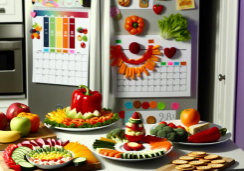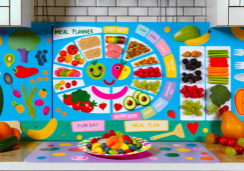Monthly Meal Blueprint for Couples
Imagine you've just spent a relaxing Sunday evening savoring a Lazy Lasagna for 2, a dish that took you less than an hour to prepare and didn't leave a mountain of leftovers.
As a couple, you're always looking for ways to streamline your weekly routine, and meal planning is no exception. You're well aware that a well-crafted Monthly Meal Blueprint can save you time, reduce food waste, and keep both your waistline and your budget in check.
But where do you start? From understanding each other's dietary preferences to mastering the art of efficient grocery shopping, there's a smorgasbord of strategies that can transform your approach to meals.
And while it may seem that creating a monthly meal plan is a straightforward task, you'll soon discover it's about more than just picking recipes – it's about crafting a sustainable and enjoyable way of eating together.
Stay tuned to uncover the secrets that will make your mealtime both a gastronomic and a bonding experience.
Assessing Dietary Preferences
Before crafting a shared meal plan, it's essential to discuss each person's favorite cuisines and flavors, ensuring that both partners' tastes are represented in the meals you prepare together. This step is crucial in acknowledging dietary preferences that influence meal planning. You'll want to consider any dietary restrictions or allergies to guarantee all Recipes to Try are enjoyable and safe for consumption.
In addition to flavors, address the amount of food that suits each of you. Determine preferred portion sizes and meal frequencies to align your meal plan with your nutritional needs and lifestyle. It's not just about what you eat but also how much and how often.
Further, delve into cooking methods that you both prefer, whether it's baking, grilling, steaming, or sautéing. Ingredient preferences are just as important; they affect not only the taste but also the nutritional value of your meals. By exploring these preferences together, you can tailor recipes that are both satisfying and health-conscious.
Lastly, remember that meal planning is a collaborative effort. Seek feedback and input regularly to ensure that the meal plan remains balanced and enjoyable for both of you. This ongoing communication will help refine your meal strategy over time.
Budgeting for Two
Having established your dietary preferences and cooking methods, it's crucial to now focus on managing your food finances effectively by setting a meal budget for the two of you. Creating a Monthly Meal Plan is the first step toward achieving this.
When you allocate a specific budget for meals, you'll spend less and gain better control over your financial health. Integrating affordable and versatile ingredients into your plan helps stretch your dollar without sacrificing nutrition.
For two people, consider buying in bulk, which can lead to significant savings. Also, take advantage of seasonal produce, which isn't only cheaper but often at its peak in flavor and nutrients. This approach minimizes food waste and supports a balanced diet.
Drafting detailed shopping lists before heading to the store prevents impulse purchases, ensuring you stick to your budget. Additionally, purchasing store-brand products rather than name brands can lead to more savings without compromising quality. Look out for specials and discounts to further reduce expenses.
Weekly Shopping Strategies
To optimize your weekly grocery excursions, integrate a strategic approach that balances budget-conscious choices with nutrient-rich selections. Start by crafting detailed meal plans for the week ahead. This ensures you're only buying what you need, reducing waste and saving money.
When you're grocery shopping, keep an eye out for sales and discounts on staple items; these can be a great opportunity to stock up on essentials without breaking the bank. Don't be afraid to try new ingredients, especially when they're on offer. This can add variety to your diet and may even lead to discovering more affordable alternatives.
Always shop with a budget in mind. It's easy to get carried away with impulse purchases, but sticking to your list can help you avoid overspending. Buying in bulk can be cost-effective for frequently used ingredients. However, be mindful of the shelf life to prevent spoilage.
And remember, local farmers' markets are an excellent source for fresh and affordable produce, which supports local communities and can provide you with the freshest options for your meal plans.
Diverse Meal Preparation
Embracing diverse meal preparation, you'll discover a world of flavors that can transform your dining experience from routine to remarkable, ensuring your meals are both nutritionally balanced and exciting to the palate. Every week, take the opportunity to infuse your meal plan with a variety of cuisines and cooking techniques. This approach not only broadens your taste horizons but also encourages the intake of a wide range of nutrients.
Integrate regional influences like Southern, Southwestern, or Midwestern cuisine to spice up your menu. Side dishes can be as simple as Southern tomato sandwiches or as intricate as garden chickpea salads. The key is to maintain a balance between ease and flavor, offering quick stovetop meatloaf alongside more elaborate dishes like lazy lasagna.
Diverse meal preparation caters to different dietary preferences, allowing you and your partner to enjoy plant-based, vegetarian, and meat-centered dishes. This ensures that each meal is a fit for both of your nutritional needs and taste buds. As you explore new recipes each week, you're not just nourishing your bodies; you're also nurturing a shared culinary adventure that can strengthen your bond as a couple.
Managing Leftovers Efficiently
Efficiently managing leftovers can significantly reduce food waste while providing you with quick and nutritious meal options. Every time you make meal plans, include a strategy for leftovers to ensure nothing goes to waste. By doing so, you'll not only save money but also make the most of the nutrients in your food.
Here are some tips to help you manage leftovers efficiently:
- Store leftovers in clear, labeled containers for easy identification and use in upcoming meals.
- Plan a specific 'leftover night' each week to enjoy anything else that hasn't been repurposed.
- Get creative by using leftovers as the base for new, exciting dishes.
When you're making your meal blueprint for the month, remember that leftovers can be the building blocks for subsequent meals. Transform yesterday's roasted veggies into a vibrant frittata or toss the remaining chicken into a fresh salad. This approach not only streamlines meal preparation but also supports a balanced diet by repurposing nutrient-dense foods.
Make meal times something to look forward to, even when they involve leftovers. Managing leftovers efficiently means you'll have more time to enjoy each other's company, without the pressure of cooking something new every single night.
Frequently Asked Questions
How Do I Create a Monthly Meal Plan?
To create a meal plan, consider your dietary preferences, use budget-friendly tips, pick seasonal ingredients, and establish a recipe rotation for variety. Ensure it's nutrient-focused and balanced for a healthy diet.
Are Monthly Meal Plans Worth It?
Absolutely, monthly meal plans are worth it. They offer budget benefits, help with dietary considerations, enhance time management, and increase grocery shopping efficiency, supporting a balanced, nutrient-focused lifestyle.
How Do I Plan a Meal With My Partner?
To plan meals with your partner, discuss shared preferences and dietary restrictions. Balance your budget, and swap recipes for a nutrient-focused, balanced diet. This teamwork fosters a harmonious approach to healthy eating.
How Do I Make a Menu for the Month?
To make a monthly menu, balance your budget, select seasonal produce, adjust for allergies, and rotate recipes for variety while ensuring a nutrient-focused, balanced diet based on health guidelines.
Conclusion
You've navigated dietary preferences, tailored a budget, and crafted shopping strategies for two. By embracing a diverse meal prep approach, you've ensured nutritious, palate-pleasing dishes grace your table.
Remember, managing leftovers is key to minimizing waste and maximizing value. Stick with your Monthly Meal Blueprint for Couples, and you'll continue to enjoy the harmony of health, flavor, and thrift in your shared meals.
Keep savoring the journey, together.










